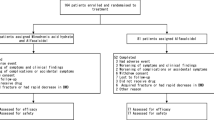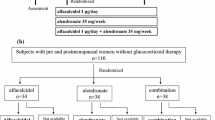Summary
We studied the effect of alphacalcidol (1-α-hydroxycholecalciferol) on bone metabolism in patients who were placed on glucocorticoid therapy. We selected 41 women (age: 32–52 yrs) who were recently diagnosed with systemic lupus erythematodes, multiple sclerosis, rheumatoid arthritis or asthma bronchiale. Patients did not have other disease or take drugs known to influence bone metabolism. Patients were randomly enrolled into two groups and were given 5–25mg prednisone daily. After 4 weeks, group A (n=21) received 0.5–1.0μg (mean=0.54±0.03μg) alphacalcidol and group B (control; n=20) was given 500mg calcium daily for three years. There were no significant differences in age and steroid doses between groups. Serum calcium (Ca), osteocalcin (OC), collagen I C-terminal propeptide (PICP), parathyroid hormone (PTH), and urinary calcium and deoxypyridinoline crosslink excretion (DPD) were measured before corticosteroid administration, and before alphacalcidol or calcium treatment as well as 6 weeks, 6 months, and 1, 2, and 3 years later. Bone mineral density (BMD) was examined before treatment and 6 months, 1, 2, and 3 years later by DEXA and SPA. OC and PICP decreased significantly after 4 weeks on steroid in both groups and increased in group A but not in group B after 6 weeks of treatment with alphacalcidol and remained unchanged for 3 years. Serum PTH increased in both groups after 4 weeks of glucocorticoid treatment and was reduced in group A, but not in group B, after 6 weeks on alphacalcidol. Serum Ca, urinary Ca, and DPD did not change significantly in either group during the study period. Lumbar spine and femoral neck BMD were significantly reduced in group B after 6 months and 1 year, respectively, and continued to decrease during the study, while no significant change in group A was observed. BMD of the radius did not change in either group for 2 years but there was a significant reduction by the third year in group B. Based on these results, alphacalcidol treatment appears to be effective in preventing glucocorticoid-induced bone loss in these patients by reducing secondary hyperparathyroidism and stimulating bone formation.
Similar content being viewed by others
Author information
Authors and Affiliations
Rights and permissions
About this article
Cite this article
Lakatos, P., Nagy, Z., Kiss, L. et al. Prevention of corticosteroid-induced osteoporosis by alfacalcidol. Z Rheumatol 59 (Suppl 1), I48–I52 (2000). https://doi.org/10.1007/s003930070040
Published:
Issue Date:
DOI: https://doi.org/10.1007/s003930070040




